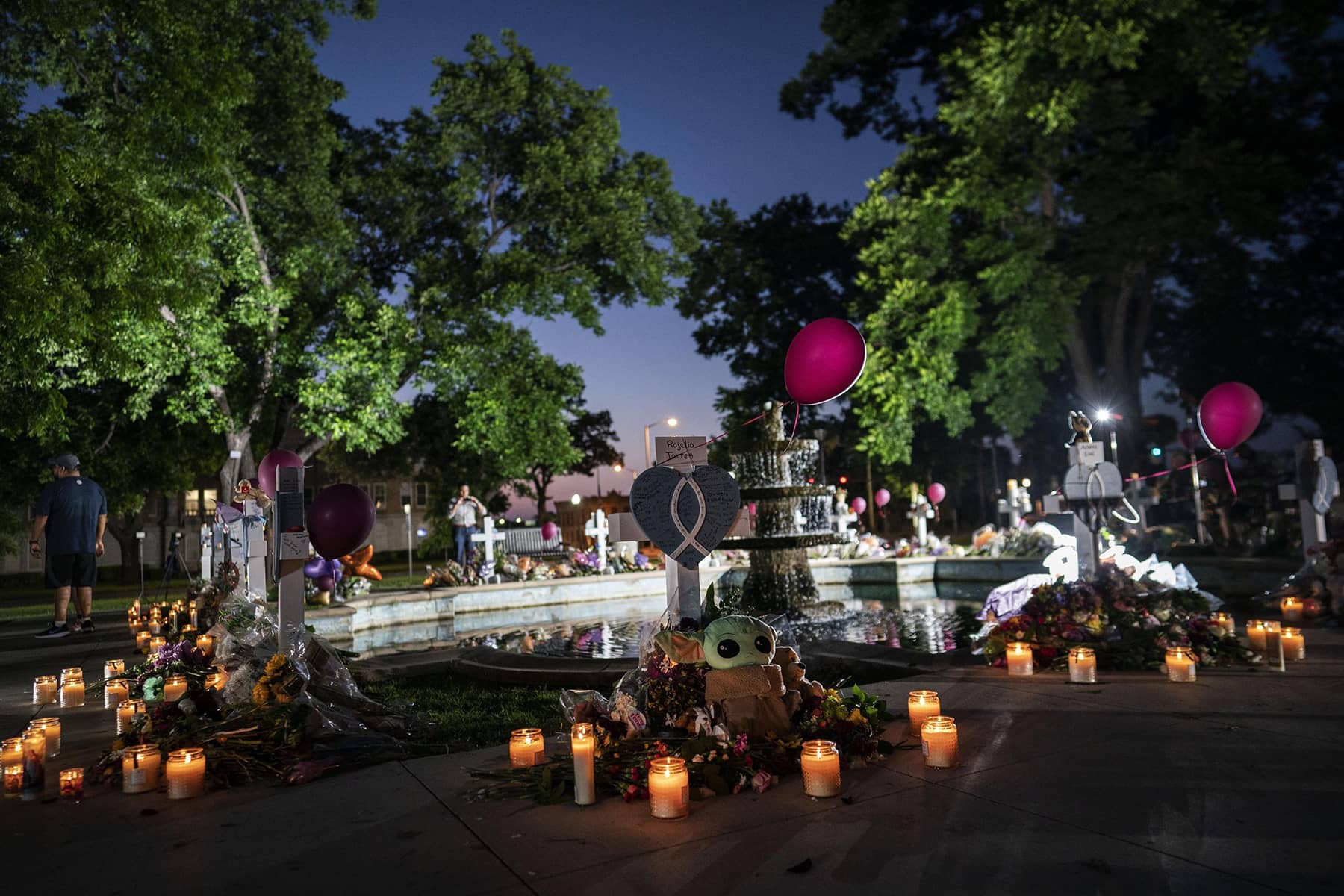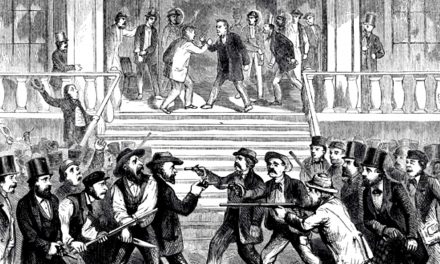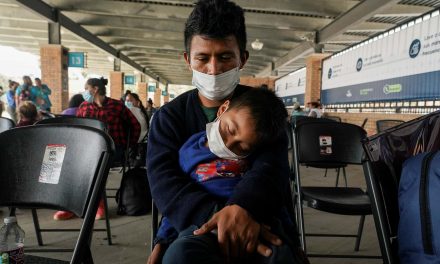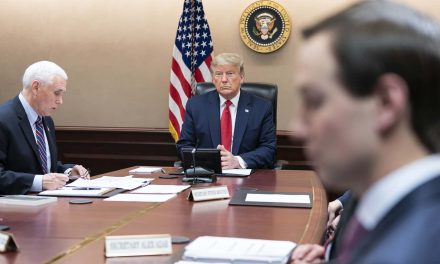
A gunman murdered at least 19 children and 2 adults at Robb Elementary School in Uvalde, Texas on May 24.
For years now, after one massacre or another, I have written some version of the same article, explaining that the nation’s current gun free-for-all is not traditional but, rather, is a symptom of the takeover of our nation by a radical extremist minority. The idea that massacres are “the price of freedom,” as right-wing personality Bill O’Reilly said in 2017 after the Mandalay Bay massacre in Las Vegas, in which a gunman killed 60 people and wounded 411 others, is new, and it is about politics, not our history.
The Second Amendment to the Constitution, on which modern-day arguments for widespread gun ownership rest, is one simple sentence: “A well regulated militia, being necessary for the security of a free state, the right of the people to keep and bear arms, shall not be infringed.” There’s not a lot to go on about what the Framers meant, although in their day, to “bear arms” meant to be part of an organized militia.
As the Tennessee Supreme Court wrote in 1840, “A man in the pursuit of deer, elk, and buffaloes might carry his rifle every day for forty years, and yet it would never be said of him that he had borne arms; much less could it be said that a private citizen bears arms because he has a dirk or pistol concealed under his clothes, or a spear in a cane.”
The insistence that the Second Amendment gives individuals a broad right to own guns comes from two places.
One is the establishment of the National Rifle Association in New York in 1871, in part to improve the marksmanship skills of American citizens who might be called on to fight in another war, and in part to promote in America the British sport of elite shooting, complete with hefty cash prizes in newly organized tournaments. Just a decade after the Civil War, veterans jumped at the chance to hone their former skills. Rifle clubs sprang up across the nation.
By the 1920s, rifle shooting was a popular American sport. “Riflemen” competed in the Olympics, in colleges, and in local, state, and national tournaments organized by the NRA. Being a good marksman was a source of pride, mentioned in public biographies, like being a good golfer. In 1925, when the secretary of the NRA apparently took money from ammunition and arms manufacturers, the organization tossed him out and sued him.
NRA officers insisted on the right of citizens to own rifles and handguns but worked hard to distinguish between law-abiding citizens who should have access to guns for hunting and target shooting and protection, and criminals and mentally ill people, who should not. In 1931, amid fears of bootlegger gangs, the NRA backed federal legislation to limit concealed weapons; prevent possession by criminals, the mentally ill and children; to require all dealers to be licensed; and to require background checks before delivery. It backed the 1934 National Firearms Act, and parts of the 1968 Gun Control Act, designed to stop what seemed to be America’s hurtle toward violence in that turbulent decade.
But in the mid-1970s, a faction in the NRA forced the organization away from sports and toward opposing “gun control.” It formed a political action committee (PAC) in 1975, and two years later it elected an organization president who abandoned sporting culture and focused instead on “gun rights.”
This was the second thing that led us to where we are today: leaders of the NRA embraced the politics of Movement Conservatism, the political movement that rose to combat the business regulations and social welfare programs that both Democrats and Republicans embraced after World War II.
Movement Conservatives embraced the myth of the American cowboy as a white man standing against the “socialism” of the federal government as it sought to level the economic playing field between Black Americans and their white neighbors. Leaders like Arizona Senator Barry Goldwater personified the American cowboy, with his cowboy hat and opposition to government regulation, while television Westerns showed good guys putting down bad guys without the interference of the government.
In 1972, the Republican platform had called for gun control to restrict the sale of “cheap handguns,” but in 1975, as he geared up to challenge President Gerald R. Ford for the 1976 presidential nomination, Movement Conservative hero Ronald Reagan took a stand against gun control. In 1980, the Republican platform opposed the federal registration of firearms, and the NRA endorsed a presidential candidate—Reagan for the first time.
When President Reagan took office, a new American era, dominated by Movement Conservatives, began. And the power of the NRA over American politics grew.
In 1981 a gunman trying to kill Reagan shot and paralyzed his press secretary, James Brady, and wounded Secret Service agent Tim McCarthy and police officer Thomas Delahanty. After the shooting, then-representative Charles Schumer (D-NY) introduced legislation that became known as the Brady Handgun Violence Prevention Act, or the Brady Bill, to require background checks before gun purchases. Reagan, who was a member of the NRA, endorsed the bill, but the NRA spent millions of dollars to defeat it.
After the Brady Bill passed in 1993, the NRA paid for lawsuits in nine states to strike it down. Until 1959, every single legal article on the Second Amendment concluded that it was not intended to guarantee individuals the right to own a gun. But in the 1970s, legal scholars funded by the NRA had begun to argue that the Second Amendment did exactly that.
In 1997, when the Brady Bill cases came before the Supreme Court as Printz v. United States, the Supreme Court declared parts of the measure unconstitutional.
Now a player in national politics, the NRA was awash in money from gun and ammunition manufacturers. By 2000 it was one of the three most powerful lobbies in Washington. It spent more than $40 million on the 2008 election. In that year, the landmark Supreme Court decision of District of Columbia v. Heller struck down gun regulations and declared that the Second Amendment protects an individual’s right to keep and bear arms.
Increasingly, NRA money backed Republican candidates. In 2012 the NRA spent $9 million in the presidential election, and in 2014 it spent $13 million. Then, in 2016, it spent over $50 million on Republican candidates, including more than $30 million on Trump’s effort to win the White House. This money was vital to Trump, since many other Republican super PACs refused to back him. The NRA spent more money on Trump than any other outside group, including the leading Trump super PAC, which spent $20.3 million.
The unfettered right to own and carry weapons has come to symbolize the Republican Party’s ideology of individual liberty. Lawmakers and activists have not been able to overcome Republican insistence on gun rights despite the mass shootings that have risen since their new emphasis on guns. Even though 90% of Americans—including nearly 74% of NRA members—support background checks, Republicans have killed such legislation by filibustering it.
President Joe Biden spoke to the nation: “Why are we willing to live with this carnage? Why do we keep letting this happen?… It’s time to turn this pain into action. For every parent, for every citizen in this country, we have to make it clear to every elected official in this country, it’s time to act.” In the Senate, Chris Murphy (D-CT) said, “I am here on this floor, to beg, to literally get down on my hands and knees and beg my colleagues … find a way to pass laws that make this less likely.”
But it was Steve Kerr, the coach of the Golden State Warriors basketball team, whose father was murdered by gunmen in Beirut, Lebanon, in 1984, who best expressed the outrage of the nation. At a press conference, shaking, he said, “I’m not going to talk about basketball … Any basketball questions don’t matter … Fourteen children were killed 400 miles from here, and a teacher, and in the last ten days we’ve had elderly Black people killed in a supermarket in Buffalo, we’ve had Asian churchgoers killed in Southern California, and now we have children murdered at school. WHEN ARE WE GONNA DO SOMETHING? I’m tired, I’m so tired of getting up here and offering condolences to the devastated families … I’m tired of the moments of silence. Enough. There’s 50 senators…who refuse to vote on HR 8, which is a background check rule that the House passed a couple years ago … [N]inety percent of Americans, regardless of political party, want…universal background checks … We are being held hostage by 50 senators in Washington who refuse to even put it to a vote despite what we the American people want … because they want to hold onto their own power. It’s pathetic. I’ve had enough.”
How have we arrived at a place where 90% of Americans want to protect our children from gun violence, and yet those who are supposed to represent us in government are unable, or unwilling, to do so? This is a central problem not just for the issue of gun control, but for our democracy itself.
It seems that during the Cold War, American leaders came to treat democracy and capitalism as if they were interchangeable. So long as the United States embraced capitalism, by which they meant an economic system in which individuals, rather than the state, owned the means of production, liberal democracy would automatically follow.
That theory seemed justified by the fall of the Soviet Union in 1991. The crumbling of that communist system convinced democratic nations that they had won, they had defeated communism, their system of government would dominate the future. Famously, in 1992, political philosopher Francis Fukuyama wrote that humanity had reached “the universalization of Western liberal democracy as the final form of human government.” In the 1990s, America’s leaders believed that the spread of capitalism would turn the world democratic as it delivered to them global dominance, but they talked a lot less about democracy than they did about so-called free markets.
In fact, the apparent success of capitalism actually undercut democracy in the U.S. The end of the Cold War was a gift to those determined to destroy the popular liberal state that had regulated business, provided a basic social safety net, and invested in infrastructure since the New Deal. They turned their animosity from the Soviet Union to the majority at home, those they claimed were bringing communism to America. “For 40 years conservatives fought a two-front battle against statism, against the Soviet empire abroad and the American left at home,” right-wing operative Grover Norquist said in 1994. “Now the Soviet Union is gone and conservatives can redeploy. And this time, the other team doesn’t have nuclear weapons.”
Republicans cracked down on Democrats trying to preserve the active government that had been in place since the 1930s. Aided by talk radio hosts, they increasingly demonized their domestic political opponents. In the 1990 midterm elections, a political action committee associated with House Republican whip Newt Gingrich gave to Republican candidates a document called “Language: A Key Mechanism of Control.” It urged candidates to label Democrats with words like “decay,” “failure,” “crisis,” “pathetic,” “liberal,” “radical,” “corrupt,” and “taxes,” while defining Republicans with words like “opportunity,” “moral,” “courage,” “flag,” “children,” “common sense,” “hard work,” and “freedom.” Gingrich later told the New York Times his goal was “reshaping the entire nation through the news media.”
Their focus on capitalism undermined American democracy. They objected when the Democrats in 1993 made it easier to register to vote by passing the so-called Motor-Voter Act, permitting voters to register at certain state offices. The next year, losing Republican candidates argued that Democrats had won their elections with “voter fraud.” In 1996, House and Senate Republicans each launched yearlong investigations into what they insisted were problematic elections, one in Louisiana and one in California. Ultimately, they turned up nothing, but keeping the cases in front of the media for a year helped to convince Americans that voter fraud was a serious issue and that Democrats were winning elections thanks to illegal, usually immigrant, voters.
In 2010 the Supreme Court green-lit the flood of corporate money into our political system with the Citizens’ United decision; in 2013 it gutted the provision of the 1965 Voting Rights Act requiring the Department of Justice to sign off on changes to election laws in some states, prompting a slew of discriminatory voter ID laws. In 2010, REDMAP (Redistricting Majority Project) enabled Republicans to take over state legislatures and gerrymander the states dramatically in their own favor.
At the same time, the rise of a market-based economy in the former Soviet republics made it clear that capitalism and democracy were not interchangeable. An oligarchy rose from the ashes of the USSR, and U.S. leaders embraced the leaders of that new system as allies. That allyship has gone so far that this week, the Conservative Political Action Conference held a conference in Hungary, where leader Viktor Orbán, who was a keynote speaker at the event, has openly rejected democracy. At the conference, he called for the right in the U.S. to join forces with those like him, he declared martial law in his country.
At home, where our focus on free markets has stacked our political system in favor of the Republicans, the vast majority of Americans want reasonable gun laws, reproductive rights, action on climate change, equality before the law, infrastructure funding, and so on, and their representatives are unable to get those things. Capitalism, it seems, is also trumping democracy at home.
One of the key things that drove the rise of the current Republican Party was the celebration of a certain model of an ideal man, patterned on the image of the American cowboy. Republicans claimed to be defending individual men who could protect their families if only the federal government would stop interfering with them. Beginning in the 1950s, those opposed to government regulation and civil rights decisions pushed the imagery of the cowboy, who ran cattle on the Great Plains from 1866 to about 1886 and who, in legend, was a white man who worked hard, fought hard against Indigenous Americans, and wanted only for the government to leave him alone.
That image was not true to the real cowboys, at least a third of whom were Black or men of color, or to the reality of government intervention in the Great Plains, which was more extensive there than in any other region of the country. It was a reaction to federal laws after the Civil War defending Black rights in the post–Civil War South, laws white racists said were federal overreach that could only lead to what they insisted was “socialism.”
In the 1950s, the idea of an individual hardworking man taking care of his family and beholden to no one was an attractive image to those who disliked government protection of civil rights, and politicians who wanted to dissolve business regulation pulled them into the Republican Party by playing to the mythology of movie heroes like John Wayne. Part of that mythology, of course, was the idea that men with guns could defend their families, religion, and freedom against a government trying to crush them. By the 1980s, the National Rifle Association had abandoned its traditional stance promoting gun safety and was defending “gun rights” and the Republican Party; in the 1990s, talk radio hosts like Rush Limbaugh fed the militia movement with inflammatory warnings that the government was coming for a man’s guns, destroying his ability to protect his family.
That cowboy image has stoked an obsession with guns and with military hardware and war training in police departments. It feeds a conviction that true men dominate situations, both at home and abroad, with violence. That dominance, in turn, is supposed to protect society’s vulnerable women and children.
In 2008, in the District of Columbia v. Heller decision, the Supreme Court said that individuals have a right to own firearms outside of membership in a militia or for traditional purposes such as hunting or self-defense, and dramatically limited federal regulation of them. Justice Antonin Scalia, who wrote the majority decision, was a leading “originalist” on the court, eager to erase the decisions of the post-WWII courts that upheld business regulation and civil rights.
In 2004, a ten-year federal ban on assault weapons expired, and since then. mass shootings have tripled. Zusha Elinson, who is writing a history of the bestselling AR-15 military style weapon used in many mass shootings, notes that there were about 400,000 AR-15 style rifles in America before the assault weapons ban went into effect in 1994. Today, there are 20 million.
For years now, Republicans have stood firmly against measures to guard Americans against gun violence, even as a majority of Americans support commonsense measures like background checks. Notably, after the Sandy Hook Elementary School massacre in 2012, when a gunman murdered 20 six- and seven-year-old students and 6 staff members, Republicans in the Senate filibustered a bipartisan bill sponsored by Joe Manchin (D-WV) and Pat Toomey (R-PA) that would have expanded background checks, killing it despite the 55 votes in favor of it.
Since Sandy Hook, the nation has suffered more than 3500 mass shootings, and Republicans have excused them by claiming they didn’t actually happen, or by insisting we need more guns so there will be “a good guy with a gun” to take out a shooter, or that we need to “harden targets,” or that we need more police in the schools (which has simply led to more student arrests), or as Senator Ted Cruz said, to limit the number of doors in schools, or, as a guest on Fox News Channel personality Sean Hannity’s show said, to put “mantraps” and trip wires in the schools.
The initial story of what happened on in Uvalde fit the Republican myth. Police spokespeople told reporters that a school district police officer confronted the shooter outside the building before he barricaded himself in a classroom, killing 19 and wounding 22 others in his rampage. But as more details are emerging, they are undermining the myth itself.
Robb Elementary School, where the murders took place, had already been “hardened” with the town investing more than $650,000 in security enhancements, but the shooter apparently entered through an unlocked door. The Uvalde police department consumes 40% of the town’s budget and has its own Special Weapons and Tactics (SWAT) unit. And yet, the stories that are emerging from Uvalde suggest that the shooter fired shots outside the school for 12 minutes before entering it and that he was not, in fact, confronted outside.
Police officers arrived at the same time he entered the school, but they did not go in until after he had been in the building for four minutes. Seven officers then entered, but the lone gunman apparently drove them out with gunfire, and they stayed outside, holding back frantic parents, until Border Patrol tactical officers arrived a full hour later.
Parents tried to get the police to go in but instead found themselves under attack for interfering with an investigation. One man was thrown to the ground and pepper sprayed. U.S. Marshals arrested and handcuffed Angeli Rose Gomez, whose children were in the school and who had had time to drive 40 miles to get to them, for interfering as she demanded they do something. Gomez got local officers she knew to talk the Marshals into releasing her. Then she jumped the school fence, ran in, grabbed her two kids, and ran out.
A Texas Department of Safety official said that the law enforcement officers at the school were reluctant to engage the gunman because “they could’ve been shot, they could’ve been killed.”
There are still many, many questions about what happened in Uvalde, but it seems clear that the heroes protecting the children were not the guys with guns, but the moms and the dads and the two female teachers who died trying to protect their students: Eva Mireles and Irma Garcia. News reports say that Garcia’s husband, Joseph, died this morning of a heart attack, leaving four children.
In the aftermath of the deadly attack on a supermarket in Buffalo, New York, Democrats in the House of Representatives quickly passed a a domestic terrorism bill. Senate majority leader Chuck Schumer (D-NY) tried to get the Senate to take it up. It would have sparked a debate on gun safety. Republicans blocked it. In the aftermath of the most recent massacre, only five Republicans have said they are willing to consider background checks for gun purchases. That is not enough to break a filibuster.
Texas candidate for governor Beto O’Rourke confronted Texas governor Greg Abbott at a press conference. Last year, Abbott signed at least seven new laws to make it easier to obtain guns, and after the Uvalde murders, he said tougher gun laws are not “a real solution.” O’Rourke offered a different vision for defending our children than stocking up on guns. “The time to stop the next shooting is right now, and you are doing nothing,” O’Rourke said, standing in front of a dais at which Abbott sat. “You said this is not predictable … This is totally predictable … This is on you, until you choose to do something different … This will continue to happen. Somebody needs to stand up for the children of this state or they will continue to be killed, just like they were killed in Uvalde.”
After shooting his grandmother in the face and taking her truck, the gunman got to Robb Elementary School at 11:28 a.m. on May 24 and started firing into the school windows. A police officer responded to a call about the shooter but drove by him, instead mistaking a teacher for the suspect. The gunman got into the school through a door that had been propped open, and began his rampage down a hallway, ending up at about 11:30 a.m. in two joined fourth-grade classrooms, 111 and 112, with students and two teachers.
He apparently closed and locked the door. He shot the teachers first, and then students. Local police responded, and several ran into the school. Two were wounded slightly at the doorway when bullets came through it. By noon, there were 19 police officers in the school and many others outside. Parents were gathering, urging the officers to charge the shooter. Officers warned them not to interfere with an ongoing investigation, arresting at least one and pinning another to the ground. By 12:15 p.m., a tactical team from the U.S. Border Patrol arrived at the school.
But there appears to have been confusion about who was in charge. Uvalde is a town of about 16,000 people, and it has a six-officer department to oversee eight schools, as well as a city police force with a SWAT team. The first people on the scene were city officers, but Pedro Arredondo, the chief of police for the Uvalde Consolidated Independent School District, took charge.
Arredondo apparently ordered the officers not to rush the classroom despite the sporadic gunfire coming from it. The head of the Texas state police, Steven C.McCraw, said that, despite decades of active shooter trainings that call for rushing a gunman, Arredondo decided that the gunman had barricaded himself in the classroom and was no longer an active shooter, and thus there were no children at risk. He decided to wait for more equipment and more officers to arrive before attempting to break into the room.
At least two children trapped in the classroom with the shooter called 911 at least eight times during the siege to beg for help. “Please send the police now,” one girl whispered on one of her several calls.
At about 12:50 p.m., the Border Patrol officers got a key from a janitor, unlocked the door, stormed the room and killed the gunman. The gunman was in the school for 78 minutes before law enforcement officers went in after him. He killed 21 people and wounded 17 more.
In a press conference, McCraw called the delay in rushing the gunman “the wrong decision.” Asked what he would say to the parents, he responded: “I don’t have anything to say to the parents, other than what happened. We are not here to defend what happened, we are here to report the facts … If I thought it would help, I would apologize.”
The events in Uvalde have dealt a devastating blow to the theory that a good guy with a gun will prevent gun violence. A Politico/Morning Consult poll out Wednesday showed “huge support” for gun regulations. It showed that 88% of voters strongly or somewhat support background checks on all gun sales, while only 8% strongly or somewhat oppose such checks. That’s a net approval of +80.
Preventing gun sales to people who have been reported to police as dangerous by a mental health provider is supported by 84% of voters while only 9% oppose it, a net approval of +75. Seventy-seven percent of voters support requiring guns to be stored in a safe storage unit, while only 15% oppose such a requirement, a net approval of +62.
A national database for gun sales gets 75% approval and 18% disapproval, a net approval rate of +57. Banning assault style weapons like the AR-15 has an approval rate of 67% of voters while only 25% disapprove. That’s a net approval of +42. And fifty-four percent of voters approve of arming teachers with concealed weapons, while only 34% oppose it, a net approval of +20.
And yet, their opposition to regulation and their embrace of cowboy individualism means Republicans have made it clear they will not entertain any measures to regulate gun ownership, except perhaps the last one, which teachers, parents, students, and the two largest teachers’ unions all overwhelmingly oppose.
The party appears to be doubling down on their support for expanded gun rights, trying to convince gun owners that the regulations under which we lived until 2004 will somehow end gun ownership altogether. Texas Senator Ted Cruz seemed to be trying to distract the popular fury over the massacre with an argument that schools need fewer doors, a nonsensical argument that seemed designed to derail the public conversation as people go down rabbit holes talking about fire safety and extended school campuses, gym class, and recess, and murderers who simply pull fire alarms.
But there is something else huge at work in the country right now, too. Protests against the weaponry that makes gun violence the leading cause of death for those between the ages of 1 and 24 are spreading. More than 4000 protesters, including Beto O’Rourke, the Democratic candidate for Texas governor, gathered in the 93 degree heat outside the NRA convention to share their stories of gun violence and their contempt for leaders who refuse to stand against it. Children stood with pictures of the children murdered in Uvalde with signs that said: “Am I next?” O’Rourke told the crowd: “The time for us to stop mass shootings in this country is right now, right here.”
Jocelyn Benson, the Michigan secretary of state who stood up to Trump when he accused her of preparing to rig the vote in 2020, tweeted: “The only thing that can stop a bad politician with a vote is a good citizen with a vote.”
Wоng Mаyе
Letters from an Аmerican is a daily email newsletter written by Heather Cox Richardson, about the history behind today’s politics














